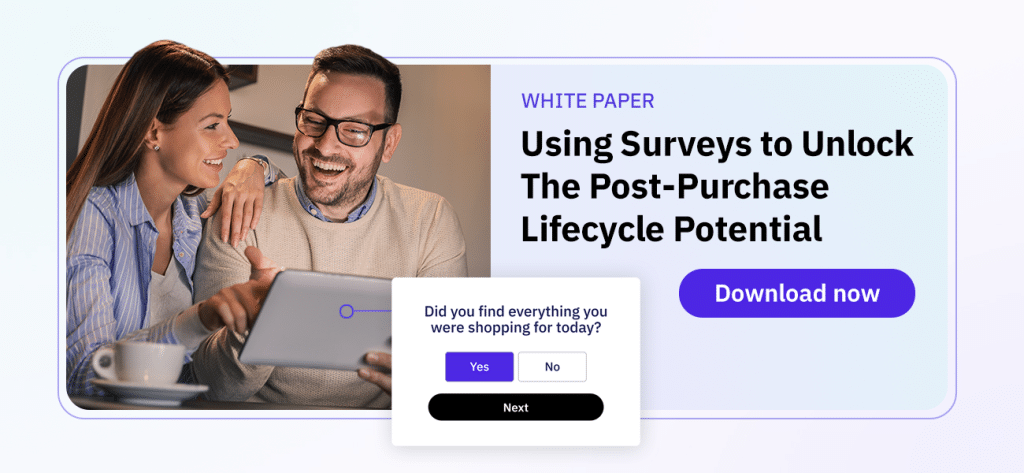
- Customer Experience
- Customer Loyalty
- Customer Marketing
- Customer Retention
- Ecommerce Marketing
- Loyalty
The Biggest Ecommerce Trends to Follow in 2025 (According to the Experts)
Megan Wenzl | Dec 2, 2024
Jan 17, 2023 | 10 minute read

Lindsay Kolinsky
Director of Marketing
The perfect customer experience doesn’t come together overnight. Key to optimizing your customer experience is understanding how your customers feel about your brand at any given moment, and using this feedback to make necessary updates and improvements to your customer journey.
Net Promoter Score (NPS) and Customer Satisfaction Score (CSAT) are two of the most popular frameworks brands use to gain these insights. Whether deployed as part of an ongoing campaign or used to gather insights in-the-moment, NPS and CSAT surveys help you to identify specific drivers of both customer frustration and happiness at a peak moment of engagement – the post-purchase stage of your customer journey.

Because they are deployed at the post-purchase stage, they typically enjoy high response rates, thus enabling ecommerce marketers to dig up a treasure chest of otherwise hidden gems in the form of highly informed and actionable customer data.
With this in mind, let’s take a closer look at what exactly NPS and CSAT are, before diving into how to interpret their data to help your business.
NPS measures how loyal your customers are to your brand. It’s based on a single post-purchase survey question asking respondents to rate the likelihood that they would recommend your company, product, or service to a friend or colleague.
NPS is a valuable metric as it’s simple, easy to compare, and acts as a measure of brand performance rather than as feedback on an individual transaction. Moreover, it allows you to find your most loyal customers and use them as the model for how to build your product.
CSAT measures happiness with a product, service, or support interaction through a customer satisfaction survey that asks: “How satisfied were you with [company]?” or “How would you rate your shopping experience today?” It’s one of the most heavily benchmarked customer experience metrics outside of NPS.
Measuring CSAT is crucial as the outcome leaves you with the overall percentage of satisfied customers at your business. If for some reason the experience isn’t satisfactory, you can pinpoint why this is the case and take action to remedy the experience.
Increasing your customer retention rate by just 5% can increase profits by anywhere between 25% and 95%!
You’ve probably read this statistic before, given it’s one of the most highly cited data points in marketing and ecommerce circles.
Customer loyalty has an incredibly powerful bottom line impact. In fact, we’d bet that if Bain & Company and Harvard Business School – the original publishers behind this statistic – teamed up to conduct updated research, it would find an even greater correlation between customer loyalty and company profits. And there is more recent research to prove our hypothesis.
Financial modeling expert and VC Josh Chapman, for example, found that focusing on customer retention can increase revenue over an 18 to 24 months period by as much as 80%, reduce customer acquisition costs by over 30%, and increase total customers by 1.5x.
When you consider the economics of e-loyalty (as HBS calls it), it’s easy to understand why measuring NPS and CSAT is so critical. Today especially, rising acquisition costs and cut-throat competition are skyrocketing the importance of any action that helps you boost customer retention and improve lifetime value.
But you can’t ensure customer loyalty without first identifying what drives it – or more importantly, what’s preventing your business from improving it. The insights that NPS and CSAT deliver enables you to do exactly this. Moreover, these insights equip you to make necessary changes to your customer journey so that it’s as frictionless as possible.
As Brian Becker, CoFounder at retention marketing agency FlowCandy, notes, “Your best customers spend more. They also lower your customer acquisition costs by subsidizing your marketing efforts through reviews, referrals, and user-generated content. Your worst customers might cost you a sale or two, but they’re a valuable source of feedback. Good marketing must involve separating your best customers from your worst and messaging them accordingly. And NPS scores are an excellent way to do just that.”
As mentioned above, NPS is based on a single post-purchase survey question that looks likes this:
“On a scale of 0-10, how likely are you to recommend our brand to a colleague or friend?”
With 1 being not likely at all, and 10 being very likely.
You can also tailor the question based on your needs. So, for example, you could also ask your customers how likely they are to recommend a particular product or service to a colleague or friend.
The NPS scale allows you to segment your customers into three classifications (detractors, passives, and promoters) that measure their likelihood of recommending your brand, product or services. With these insights in hand you can then trigger important follow up questions to dig deeper into the meaning behind the scores. Here are a few examples:
Promoters: “We’re glad you like us. Can you tell us what made your experience so positive?”
Passives: “Thank you for your feedback. Would you like to tell us why you chose that score?”
Detractors: “We’re sorry to hear that. Can you tell us more about what wrong?”
To measure CSAT, you ask your customers:
“How satisfied were you with [company]?”
Again, this is an incredibly simple question that can be easily tailored to ask your customers how satisfied they were with a specific product or service, or perhaps a customer service interaction.
So how do you decide whether to use NPS or CSAT? As we discussed, in general, NPS surveys are used to measure long-term customer loyalty and satisfaction , while CSAT surveys are used to measure in-moment satisfaction with a specific product or service. If you need to measure customer loyalty, NPS surveys are the better option. If you need to measure satisfaction with a specific product or service, CSAT surveys are the better option. However, both should be used in tandem to maximize the data you can collect.
NPS classifies those who choose a rating of 9 or 10 as “promoters”, “passives” as those who rate either 7 or 8, and “detractors” as those who provide a rating below 6. You can then calculate your NPS by using this formula:
NPS = % of Promoters ( – ) % of Detractors
Based on this, your brand’s NPS score will be a number between -100 and 100.
Clearly, if your brand scores a 0, it means your business has serious customer experience issues that need to be addressed immediately. We typically consider a score between 0 and 30 as one that shows there’s some positives to be taken from your CX, but there is still work to do.
Meanwhile, scoring 30+ signifies a healthy ratio of happy customers and unhappy ones. However, every brand should aim to score 70+ as this illustrates that you’re thriving, your customers enjoy interacting with you, and as a result, you’re likely generating positive word-of-mouth through referrals.
It’s important to note, however, the challenges that arise when comparing your brand against industry benchmarks. For example, despite the fact that they can offer very different experiences, enterprises and SMBs are often grouped together. At Okendo, we recommend you focus on improving your number at small increments quarter by quarter, and tracking your revenue to see if you notice a correlation between it and your NPS score.
To calculate your CSAT score, you take the number of satisfied customers (those who give you a 4 or a 5 rating) and divide it by the total number of responses. For example, if you gathered 100 responses and 60 of those gave you a 4 or a 5 rating, then your CSAT score would be 60.
A score below 35 is considered poor. If your brand scores below 35, it means your customer turnover is high and you have a lot of work to do to boost customer satisfaction. Similarly, a score of 35-50 means you also have a lot of unsatisfied customers. Loyalty is likely extremely low, meaning you’re spending a good chunk of your marketing budget trying to attract new customers versus nurturing existing ones.
A score of 50-65 is average. It suggests that you have a healthy range of happy and unhappy customers, but there’s room for improvement. If you score between 65 and 80, congratulations! You’re doing an exceptional job and your customers are extremely satisfied with the interactions and experiences you deliver.
Remember, when collecting feedback through NPS and CSAT surveys, the goal is always to improve the customer experience and customer satisfaction. Here’s a few ways you can use these post-purchase surveys to optimize your customer journey.
NPS and CSAT surveys collect high-value customer insights which you can use to implement advanced customer targeting and consequently, more effective marketing personalization.
By combining NPS & CSAT scores with the wealth of customer data you have from the rest of your continuous insights strategy you can learn what your customers like and dislike about your product, website and brand, improve the customer journey and maximize your strengths. Teams can even analyze NPS & CSAT scores by products purchased to see how their various products and offerings are impacting their scores and use those insights to level-up their personalization.
Another way to utilize your NPS and CSAT survey insights is to engage individual customers with relevant programs based on their responses. A highly effective use for this is inviting a brand “promoter” to refer a friend through apps such as Friendbuy.
Referred friends are highly qualified because they’ve been introduced to your brand by someone they trust. As a result, referred friends convert much faster—5x faster—than those acquired through other channels.
The customer should always be at the center of your business. And while leveraging NPS and CSAT allows you to keep a pulse on how your brand is doing in customer-centricity, but the truth is that taking action on the insights these frameworks provide is absolutely crucial.
For example, with NPS & CSAT insights in hand, you can utilize your customer service teams to proactively reach out to detractors and promoters to learn more about their experiences, or resolve issues that they specify in follow-up questions. Afterall, not every detractor submits a customer service ticket so it’s important that your team uses these insights to fill blindspots to swoop in at exactly the right moment before a poor experience turns into a bad review, or worse, a lost customer. Proactively reaching out to customers, whether their experience was good or bad, shows them that you care about their experience and that their feedback matters.
Taking action with NPS and CSAT surveys has the ability to transform the trajectory of your business. They are, after all, two of the most commonly used customer experience frameworks worldwide. And when you consider the highly actionable customer feedback they collect, it’s easy to understand why this is the case. So as you continue to look for ways to rise above the competition and improve customer satisfaction, consider the power of NPS and CSAT surveys.
Related articles
Ready to learn more?